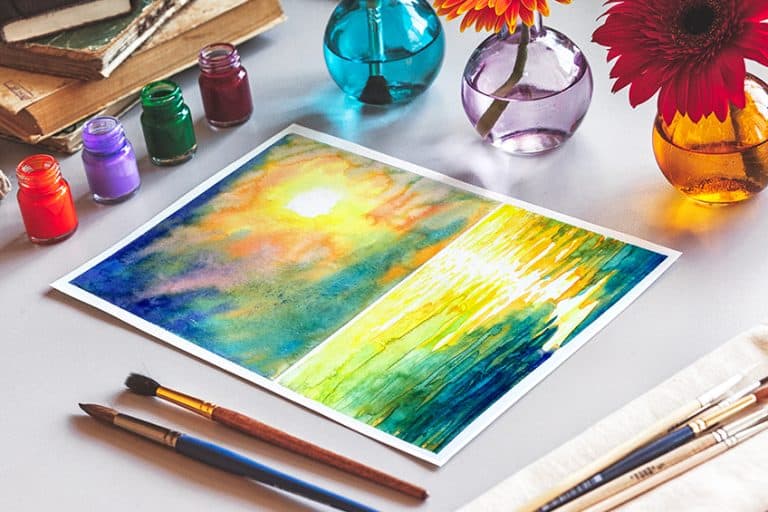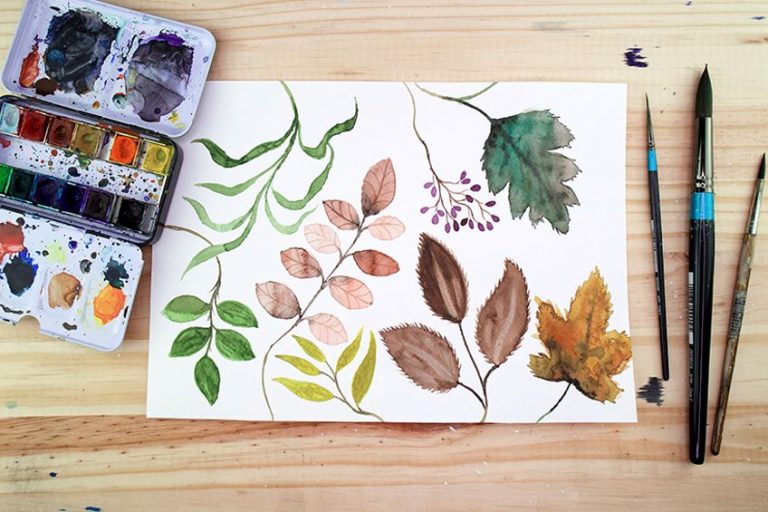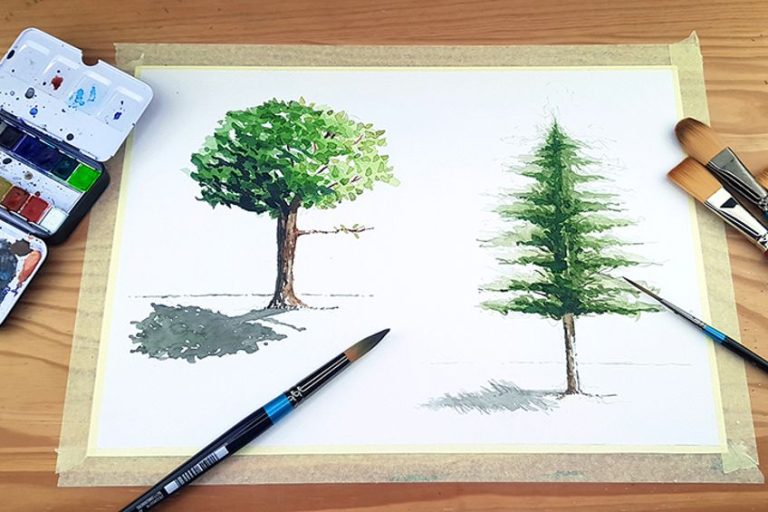What Is a Watercolor Block? – Looking at the Best Paper for Watercolor
If you are just starting out on your watercolor painting journey, you will have come across a number of unusual names for items you will need, such as pan paints, spotter and rigger brushes, watercolor blocks and pads, and so forth. In this article, we are going to focus primarily on watercolor blocks, but also on other types of paper for watercolor painting.
What Is a Watercolor Block?
The paper you select for your painting is, without a doubt, the most important part of watercolor painting. Watercolor paper is specially designed to accommodate a great deal of water without getting saturated and soggy. Even so, it has to be stretched properly in order to dry flat before you can start painting on it. Stretching paper is quite a laborious process, but fortunately, watercolor blocks have done away with the need for it.
A watercolor block looks like an ordinary pad of paper, but instead of being glued only at the top, the block is glued on all four sides. The idea is that you do your painting first, then remove the paper from the block when you have finished.
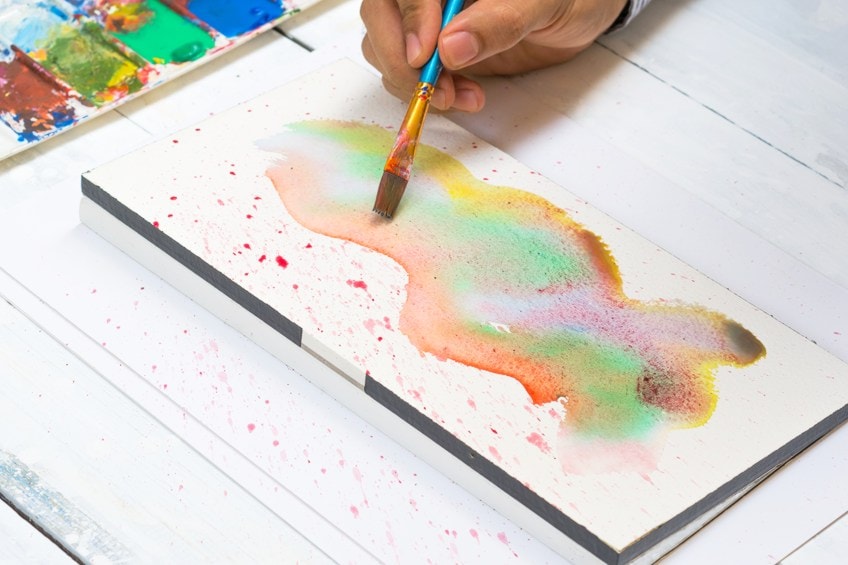
Pros and Cons of Using a Watercolor Block
There are of course advantages and disadvantages of using a watercolor block rather than a regular pad or even loose sheets of paper. It really depends on your painting set-up and your own personal preferences. That said, if you are a beginner you will want to know all the pros and cons of a paper block before you can decide if it will work for you or not.
[su_shadow style=”simple”][su_panel]PROS
- The paper has been trimmed at the edges, which means you can paint to the edge of the page and not waste any space.
- The thickness and sturdiness of the block provide a solid surface on which to paint, which means you can easily paint outside without the aid of an easel.
- Because the paper is attached on four sides, it will remain flat when you are painting on it. No chance of the page buckling under large washes of paint and water!
- Being a thick pad with a very rigid backing board, the paper is not likely to crease or crumple while you are carrying it.
- There is no need for you to stretch each sheet of watercolor paper before you can use it.
CONS
- You can only work on one painting at a time. If an artist has several commissions and is working to a deadline, then a paper block may not be the best choice for them.
- Some paper blocks tend to come apart after the first few pages have been removed, thus you are left with several loose sheets of paper. This may not be a problem if you work in a studio, but since many artists are plein air painters (in other words, they work outdoors), a stack of individual papers may not be ideal.
- The pages of a watercolor block are not stretched as tightly as they would have been by hand. However, this might just be a case of personal preference.
How to Remove a Piece of Paper From a Watercolor Block
As we said earlier, the pages of a watercolor block are glued or bound in rubber on all sides, meaning that pages cannot be torn off easily. Most binding agents are clear or off-white, although some producers use black material. You will need to look carefully for a gap in the binding into which you can insert a thin, flat object such as a palette knife. These gaps are usually in the top left or right edges of the block.
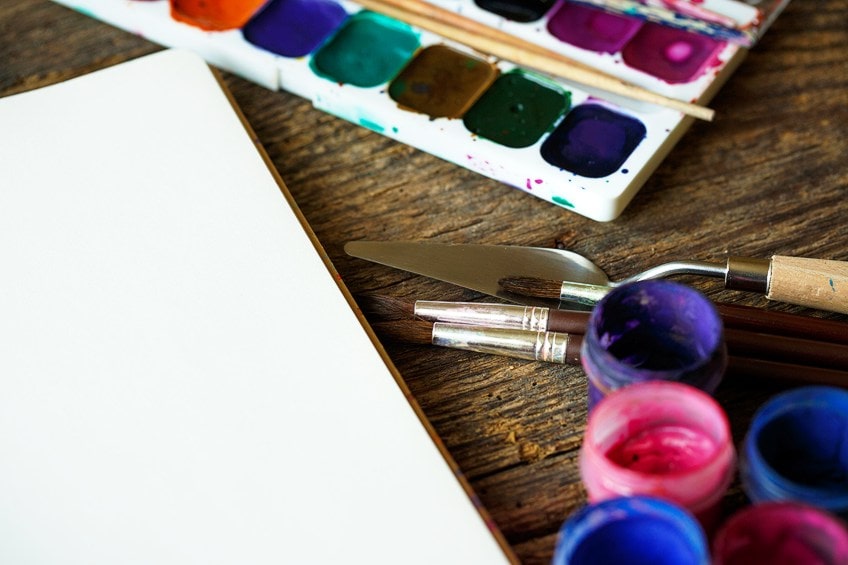
You should only need to go around the paper block once before the page comes loose, but sometimes the binding is extremely tight so you might have to run your knife around a second time.
What to Look Out For When Buying a Watercolor Paper Block
The world of watercolor paper can be a confusing place because not all paper for watercolor is created equal. There are several aspects to look out for in your watercolor paper, none of which should be ignored if you are to get the best value for your money – and for your painting!
Quality of Watercolor Paper
Quality is, without doubt, the most important thing to consider before you buy paper for watercolors, whether it is in a block or pad, or loose sheets. There are only two grades of paper: student-grade and professional-grade (also known as artist-grade). The difference is in how they are made, and what they are made of.
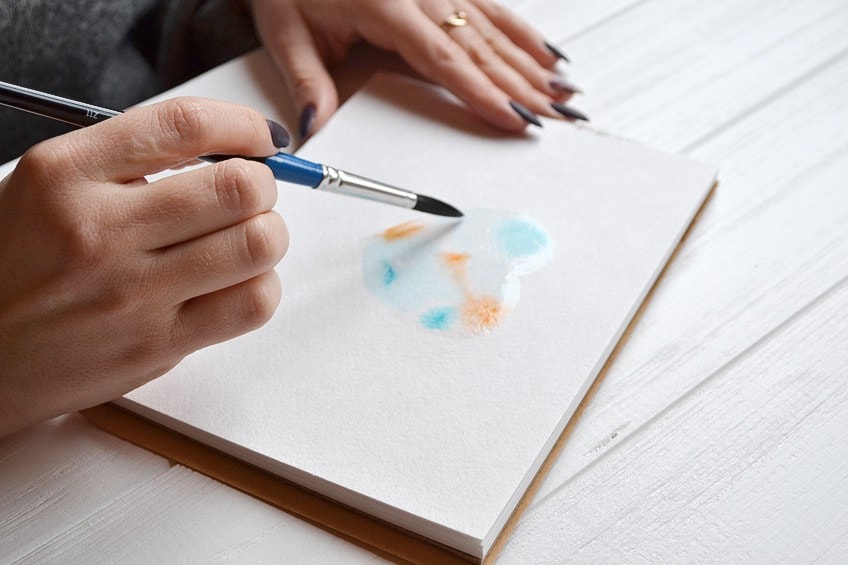
Professional (Artist)-Grade
Professional or artist-grade watercolor paper is made from 100% cotton, also known as rag paper or cotton paper. Cotton is ideal for absorbing water and gives your paintings that unique look that only watercolors can achieve. The paper is made in a mold and has a textured surface. Professional-grade paper is archival quality and is also acid-free and pH neutral.
Student-Grade
Student-grade paper is a mix of wood pulp and cellulose, and it does not absorb water the way that cotton does, so your finished painting will look different than it would on professional-grade paper. It has less texture to it because it is made by machine, and unlike professional-grade paper, it is non-archival or pH neutral. That means the paper will turn yellow in time.
Textures of Watercolor Paper
You may have come across the terms “hot-pressed”, “cold-pressed”, and “rough” in reference to paper for watercolor and not been sure what they mean. They refer to the different textures of paper and how it is made.
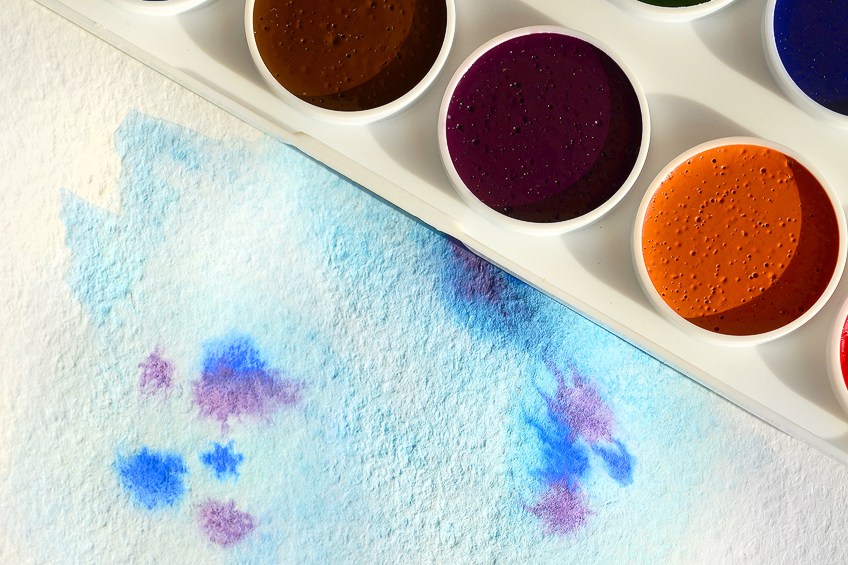
Hot-Pressed Paper
The term describes the process by which this type of paper is made. The paper pulp is pushed through heated cylinders to create paper with a smooth, almost entirely texture-free surface. Of the three different types of paper, hot pressed is the least absorbent, but you can do extremely fine detailed work, for example, botanical paintings.
Cold-Pressed Paper
The process for making cold-pressed paper is almost the same as for hot-pressed paper. Sheets of pulp are pressed through cold metal rollers that are covered in felt, which contributes to the texture of the paper. In other words, cold-pressed paper has a texture whereas hot-pressed paper does not.
Cold-pressed paper has excellent absorbency, and although you can do detailed paintings on it, they will not be as finely detailed as they would on hot pressed paper.
Rough Paper
Rough paper is made in a mold, then pressed through the same kind of felt-covered rollers that are used in making cold-pressed paper. The difference between the two types of paper is that rough paper is dried without being press-dried, which means it dries with a rough, pebbly texture to it. You would not use rough paper for detailed work, but for subjects that require a particularly textured look to them.

Weights of Watercolor Paper
You have no doubt seen reams of multipurpose printing paper marked with its weight, usually 24 lbs or 80 gsm. Paper for watercolor comes in different weights as well, the weight denoting the thickness of the paper. Just as there are three types of textured watercolor, there are three different weight categories.
- Light: Although this is more than twice the weight of printing paper, it is the lightest of the watercolor papers available, and weighs 90 lbs or 190 gsm.
- Medium: Medium-weight paper is considerably heavier than light paper, weighing 140 lbs or 300 gsm.
- Heavy: Heavy paper weighs over three times as much as a light paper at 300 lbs or 640 gsm.
More often than not, professional watercolorists will use medium-weight paper because it does not require any preparation before painting, such as stretching. There is also no need to tape it onto a board to prevent it from curling or buckling when water is applied. However, if you find yourself leaning towards working with very wet watercolors, in other words, with a lot of water, a heavy paper might be best for you.
Other Formats of Watercolor Paper
We have discussed watercolor blocks in detail in this article and alluded to other formats that watercolor paper comes in, namely, pads and sheets. Before we discuss them, there is just one more point to be mentioned about watercolor blocks and that is that they will always contain professional or artist-grade paper. Rarely, if ever, are they made up of student-grade paper. We will now look at other formats of watercolor paper.
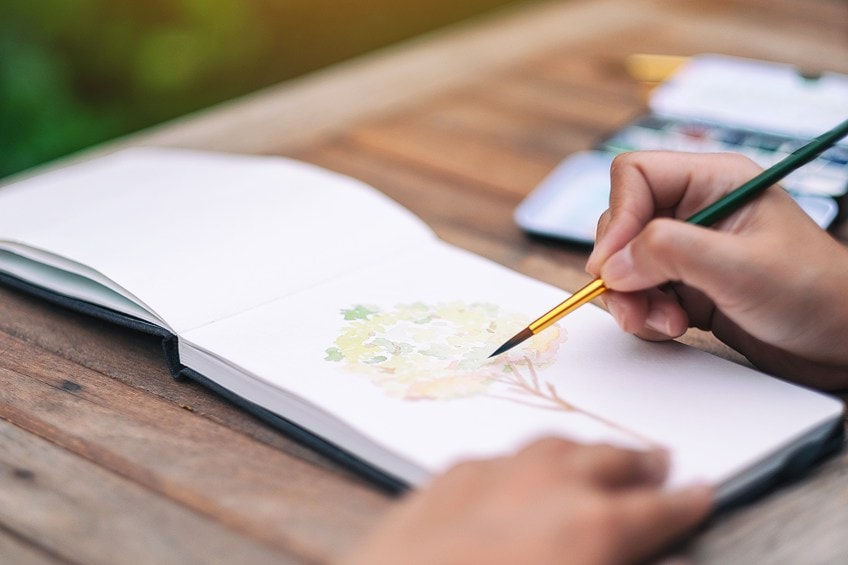
Pads of Watercolor Paper
Pads of paper for watercolors are almost always made from student-grade paper. The pads are either wire-bound, making it easy for you to turn over to a new page and start painting, or they are taped along the left-hand side or the top of the pad so you can tear off one page at a time.
Sheets of Watercolor Paper
Loose sheets of watercolor paper are bigger than the pages in a pad or a block. You can either buy them as they come or have them cut to size. More often than not it is professional watercolorists who use loose sheets because they are of the highest quality. Even so, as a beginner, you may find it more economical to buy a few sheets and have them cut to the size you want, rather than investing in a large paper block or pad.
Besides the quality of paper, another aspect of individual sheets of paper is that they are made with what is called a deckle edge. It looks like a natural tear in the paper, but only on the sides. The main body of the sheet of paper is not affected. A deckle edge just adds the finishing touch to a beautifully rendered watercolor painting.
Now that we have introduced you to watercolor blocks and acquainted you with the various aspects that make up a good piece of watercolor paper, we are sure that you will be eager to get started on your painting project! Remember, there are no rules that state which paper weight, texture, or format is better; it is entirely down to personal choice. All you need to do is enjoy the selection process and get started with your painting!
Frequently Asked Questions
What Is a Watercolor Block?
A watercolor block is a pack of professional-grade paper for watercolor that is bound or glued on all four sides. There is a small gap in the binding into which you can insert a palette knife or something similar (as long as it does not have any sharp edges), and run it around the whole block so you can tear off the page when you have finished your painting.
What Is the Best Weight of Paper for Watercolor Painting?
One weight is not necessarily better than another; it depends on the type of watercolor painting you are doing, and, of course, personal choice. However, it is generally recommended that medium-weight paper that weighs 140 lbs (or 300 gsm) be used.
Can I Use Any Texture Watercolor Paper for My Painting?
It depends entirely on what kind of painting you are doing. If it is a very finely detailed painting, hot-pressed paper, which is a smooth paper with no texture, would be ideal. Cold-pressed paper, that is, paper with a slightly textured surface is the most popular amongst watercolorists. However, artists who like to work with very wet paints would probably go for rough paper which, as its name suggests, has a rough and heavily textured surface.
Matthew Matthysen is an educated multidisciplinary artist and illustrator. He successfully completed his art degree at the University of Witwatersrand in South Africa, majoring in art history and contemporary drawing. The focus of his thesis was to explore the philosophical implications of the macro and micro-universe on the human experience. Matthew uses diverse media, such as written and hands-on components, to explore various approaches that are on the border between philosophy and science.
Matthew organized various exhibitions before and during his years as a student and is still passionate about doing so today. He currently works as a freelance artist and writer in various fields. He also has a permanent position at a renowned online gallery (ArtGazette) where he produces various works on commission. As a freelance artist, he creates several series and successfully sells them to galleries and collectors. He loves to use his work and skills in various fields of interest.
Matthew has been creating drawing and painting tutorials since the relaunch in 2020. Through his involvement with artincontext.org, he has been able to deepen his knowledge of various painting mediums. For example, watercolor techniques, calligraphy and lately digital drawing, which is becoming more and more popular.
Learn more about Matthew Matthysen and the Art in Context Team.
Cite this Article
Matthew, Matthysen, “What Is a Watercolor Block? – Looking at the Best Paper for Watercolor.” Art in Context. October 13, 2021. URL: https://artincontext.org/what-is-a-watercolor-block/
Matthysen, M. (2021, 13 October). What Is a Watercolor Block? – Looking at the Best Paper for Watercolor. Art in Context. https://artincontext.org/what-is-a-watercolor-block/
Matthysen, Matthew. “What Is a Watercolor Block? – Looking at the Best Paper for Watercolor.” Art in Context, October 13, 2021. https://artincontext.org/what-is-a-watercolor-block/.




